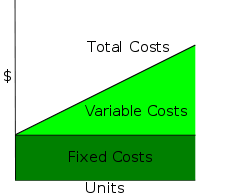Variable cost
Variable costs are costs that change as the quantity of the good or service that a business produces changes.[1] Variable costs are the sum of marginal costs over all units produced. They can also be considered normal costs. Fixed costs and variable costs make up the two components of total cost. Direct costs are costs that can easily be associated with a particular cost object.[2] However, not all variable costs are direct costs. For example, variable manufacturing overhead costs are variable costs that are indirect costs, not direct costs. Variable costs are sometimes called unit-level costs as they vary with the number of units produced.

Direct labor and overhead are often called conversion cost,[3] while direct material and direct labor are often referred to as prime cost.[3]
In marketing, it is necessary to know how costs divide between variable and fixed. This distinction is crucial in forecasting the earnings generated by various changes in unit sales and thus the financial impact of proposed marketing campaigns. In a survey of nearly 200 senior marketing managers, 60 percent responded that they found the "variable and fixed costs" metric very useful.[4]
The level of variable cost is influenced by many factors, such as fixed cost, duration of project, uncertainty and discount rate. An analytical formula of variable cost as a function of these factors has been derived. It can be used to assess how different factors impact variable cost and total return in an investment.[5]
Explanation
Example 1
Assume a business produces clothing. A variable cost of this product would be the direct material, i.e., cloth, and the direct labor. If it takes one laborer 6 yards of cloth and 8 hours to make a shirt, then the cost of labor and cloth increases if two shirts are produced.
| 1 shirt | 2 shirts | 3 shirts | |
|---|---|---|---|
| Cloth (Direct Materials) | 6yds | 12yds | 18yds |
| Labor (Direct Labor) | 8hrs | 16hrs | 24hrs |
The amount of materials and labor that goes into each shirt increases in direct proportion to the number of shirts produced. In this sense, the cost "varies" as production varies.
Example 2
For example, a firm pays for raw materials. When activity is decreased, less raw material is used, and so the spending for raw materials falls. When activity is increased, more raw material is used, and spending therefore rises. Note that the changes in expenses happen with little or no need for managerial intervention. These costs are variable costs.
A company will pay for line rental and maintenance fees each period regardless of how much power gets used. And some electrical equipment (air conditioning or lighting) may be kept running even in periods of low activity. These expenses can be regarded as fixed. But beyond this, the company will use electricity to run plant and machinery as required. The busier the company, the more the plant will be run, and so the more electricity gets used. This extra spending can therefore be regarded as variable.
In retail the cost of goods is almost entirely a variable cost; this is not true of manufacturing where many fixed costs, such as depreciation, are included in the cost of goods.
Although taxation usually varies with profit, which in turn varies with sales volume, it is not normally considered a variable cost.
For some employees, salary is paid on monthly rates, independent of how many hours the employees work. This is a fixed cost. On the other hand, the hours of hourly employees can often be varied, so this type of labour cost is a variable cost. The cost of material is a variable cost.
See also
- Cost
- Fixed cost
- Cost accounting
- Cost curve
- Cost driver
- Semi variable cost
- Total cost
- Contribution margin
Notes
- Garrison, Noreen, Brewer. Ch 2 - Managerial Accounting and Costs Concepts, pp 48
- Garrison, Noreen, Brewer. Ch 2 - Managerial Accounting and Costs Concepts, pp 51
- Garrison, Noreen, Brewer. Ch 2 - Managerial Accounting and Costs Concepts, pp 39
- Farris, Paul W.; Neil T. Bendle; Phillip E. Pfeifer; David J. Reibstein (2010). Marketing Metrics: The Definitive Guide to Measuring Marketing Performance. Upper Saddle River, New Jersey: Pearson Education, Inc. ISBN 0-13-705829-2. Content used from this source has been licensed under CC-By-SA and GFDL and may be reproduced verbatim. The Marketing Accountability Standards Board (MASB) endorses the definitions, purposes, and constructs of classes of measures that appear in Marketing Metrics as part of its ongoing Common Language in Marketing Project.
- Chen, Jing (2016). The Unity of Science and Economics: A New Foundation of Economic Theory. https://www.springer.com/us/book/9781493934645: Springer.CS1 maint: location (link)
References
- Garrison, Ray H; Eric W. Noreen; Peter C. Brewer (2009). Managerial Accounting (13e ed.). McGraw-Hill Irwin. ISBN 978-0-07-337961-6.
- Prime Cost Explanation and Examples by Play Accounting.